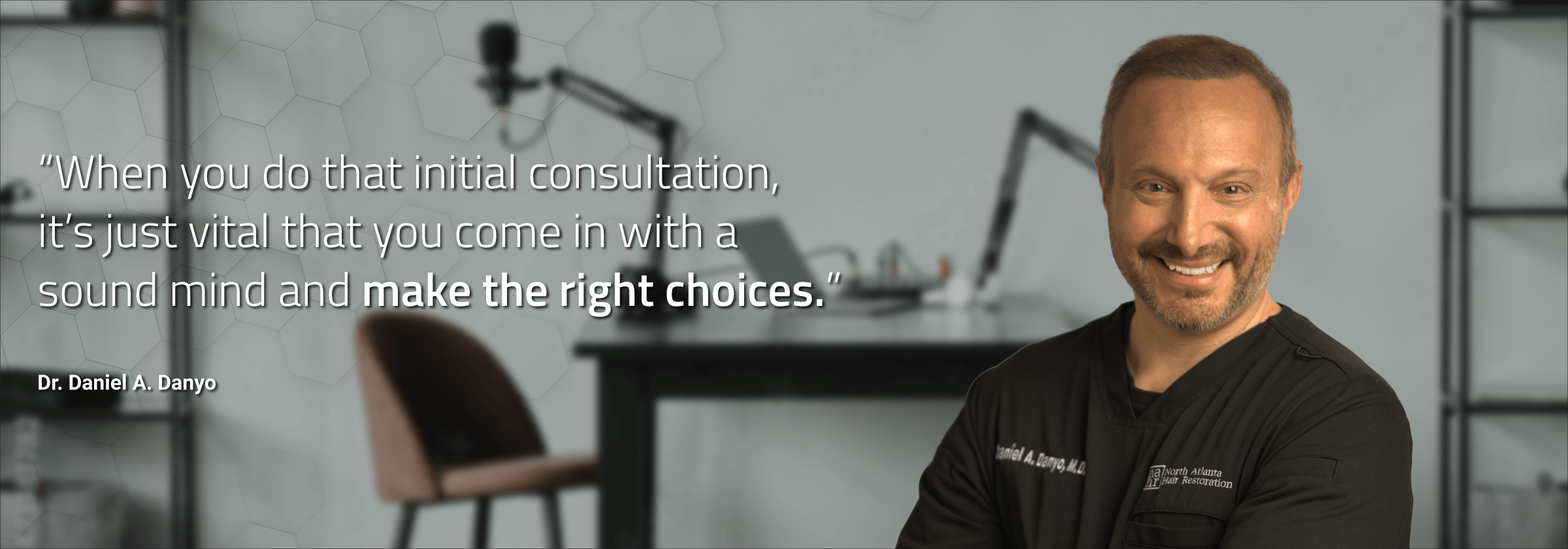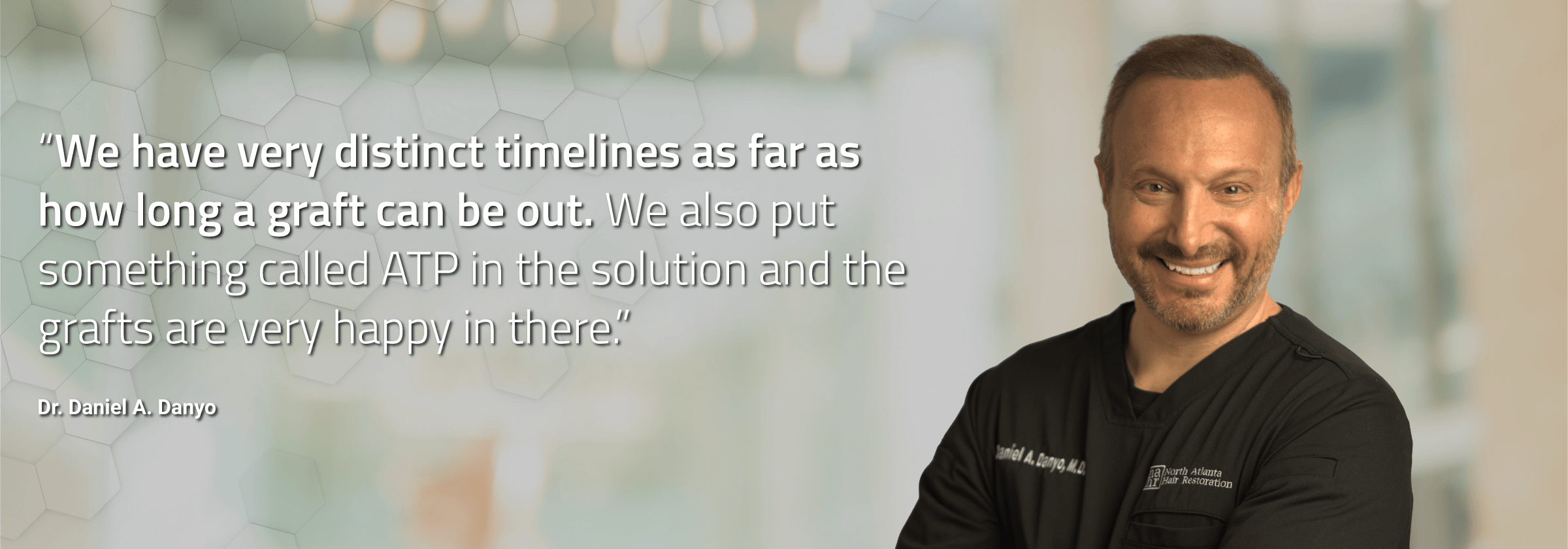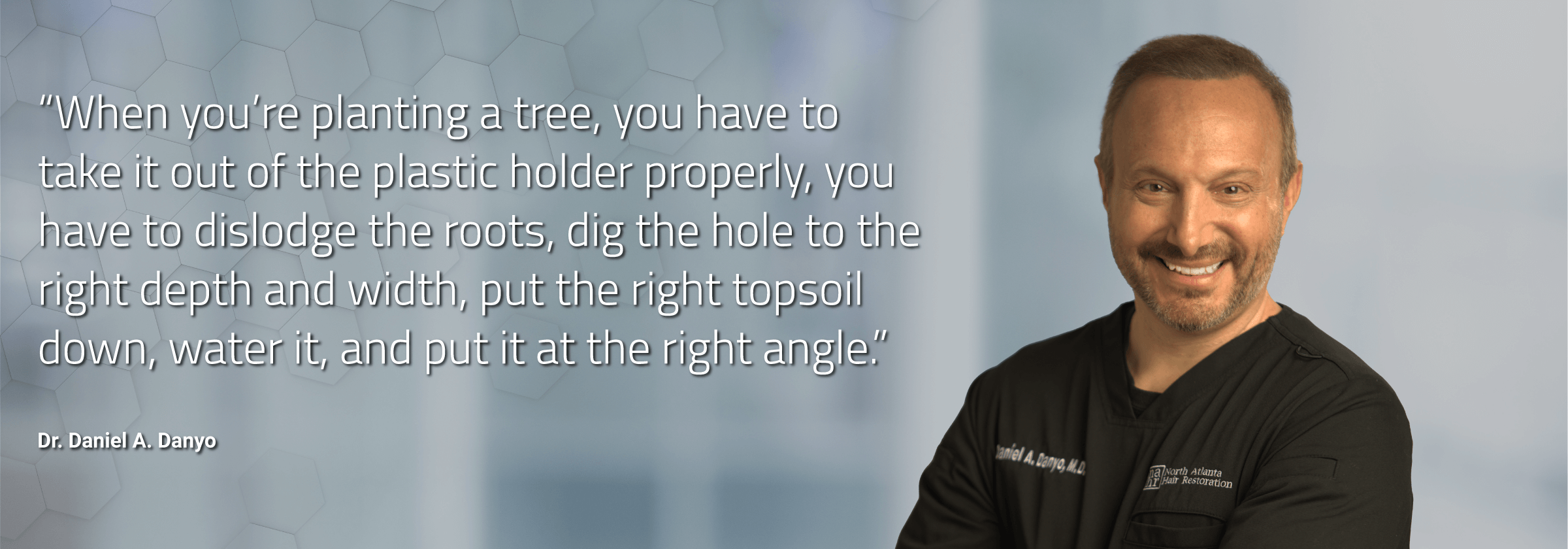The following is a transcript of Episode 5 of the Hair Restoration With Dr. Daniel A. Danyo podcast.
All episodes of the podcast can be found at Apple Podcasts, Google Podcast, and Spotify.
Dr. Danyo: When you do that initial consultation, it’s just vital that you come in with a sound mind and make the right choices because you don’t want to choose a losing proposition for somebody and create major issues.
Clark: That was the voice of Daniel A. Danyo, MD, founder and physician at North Atlanta Hair Restoration, a boutique medical practice solely dedicated to the diagnosis and treatment of male and female hair loss. You’re listening to “Hair Restoration with Dr. Daniel A. Danyo.” I’m your host, Clark, and all season long, we’ll be speaking with Dr. Danyo about how he and his team at North Atlanta Hair Restoration are helping his patients transform their everyday lives for the better.
In this episode, Dr. Danyo explains why it’s essential to have a physician involved with the hair transplantation process every step of the way. From consultation to procedure to recovery and follow-up, he breaks down why a physician is best equipped to successfully guide your hair restoration journey.
Now, let’s jump in. Dr. Danyo, how are you doing?
Dr. Danyo: I’m doing great, Clark, how about you?
Clark: I’m doing well. I know we’ve got a big topic, a really important topic that we’re going to be discussing today. And it’s all about, really, the physician’s role in this and how they need to be part of this. They need to be involved every step of the way. And…
Dr. Danyo: Absolutely.

Clark: …we’re gonna be talking about some stories around that, some examples, and also for someone thinking about engaging with you or someone like this, some of the key things to be thinking about. So, I’m excited to learn more here, but I just want to start off, when you have this one rally cry, message to tell people, why are you so passionate about having the physician part of this from the beginning through the very end?
Dr. Danyo: Well, a lot of it is based on just personal history that I’ve had two hair transplant procedures before and in the previous podcast, I talked about some of the post-operative things with a lot of swelling and having my head shaved and big bandages, and really kind of being out of the social scene and almost, and really, work scene for an extended period of time. And that kind of changed my philosophy on how I treat patients and really come up with more of a concealment package. But a lot of it also relates to the fact that I’ve been burned by having services done, you know, say, like, we had a house built, and it was an absolute disaster.
Clark: What?
Dr. Danyo: To the point where I had to fire the builder and go through arbitration. But in the meantime, I had an electrician come by, a HVC guy come by, a trim and framing guy come by. And we had to rip out so much. It was in the hundreds of thousands of dollars that we were having to repair and replace. In fact, all of the electrical and all the HVC had to be ripped out.
Clark: That’s unbelievable.
Dr. Danyo: And it had stunted the build by probably nine months. It was crazy. One of my neighbors had a recent kitchen build that took almost a year to do and they’re also in some kind of litigation. So, with that being said, I’ve had a lot of patients recently that have come in, they’ve had prior hair transplant, they had poor results in the graft area. Their hair was thin. The hairs were at weird angles. There was a real pluggy look and their donor sites…
Clark: Oh, no.
Dr. Danyo: …were really over-harvested and decimated. They looked really thin. And people come to me and they put in a lot of time, a lot of effort, a lot of money. And when we evaluate and look at the graft count it’s going to take to fix this and I have concerns about their donor sites, they’re extremely unhappy.
Clark: So that example that you’re sharing, just that concept of not being done right the first time, I think a lot of us can relate to that. So when you got into that situation with your house, can you dial in on why that happened? Is it connected to how you were sold one thing or the person who was actually building the house was not part of the process? What kind of connections do you see between that and the work you do with hair restoration?
Dr. Danyo: I think we all have a default to truth when we meet with somebody. We don’t default to doubt. So, when we meet a professional, we are expecting truth from them in that if they say they’re going to do something, and then you’re going to have this result, that they’re truthful in that they’re actually going to accomplish it and follow through with it. It just takes a series of events when you’re going through a house where you say, “Now wait a minute, this does not look right.” And to where you then default to doubt, and then you make a change. So, I think patients going into a hair transplant, especially when they look at a lot of the slick marketing and meet with different folks, they also default to truth. And unfortunately, they default to doubt after the procedure has been done and then they’re dealing with the ramifications.
Clark: So when you have someone coming to you on the front end…
Dr. Danyo: Yes.
Clark: …instead of selling someone something that is not what they need, you know, it’s possible you could even say, “Hey, this might not be the right option for you,” right?
Dr. Danyo: Absolutely.
Clark: Or you might not be capable, because if someone else does work on someone’s hair restoration, and they’re not a good candidate, you’re gonna have problems.
Dr. Danyo: Yes. So, I’ll give you an example. This week, I saw somebody who was a Norwood 7, which means he’s got complete baldness on top, really low on the sides and on the back. And his donor site was really small and also thin. And in talking with him, I asked him what his goals were. And he said he wanted hair, especially in the front, but if we could get all the way back into the crown, that would be great.
And I told him there are possibilities, but it’s a lot because your donor site is not going to support the number of grafts it would take to go from the front to back to make it look good. And we would probably have to go to the beard and the chest and you’re looking at multiple cases, a huge amount of expense. And I think there may be some other options, say, scalp micropigmentation. Or just kind of dealing with the fact that you’re not a great candidate for a hair transplant. And that’s not a bad thing to say.
I mean, the worst thing I can do as a physician, especially having a successful practice, is to over promise and under deliver and then have problems with my relationship with the patient and problems with my practice. And when you do that initial consultation, it’s just vital that you come in with a sound mind and make the right choices because you don’t want to choose a losing proposition for somebody and create major issues.
Clark: Can you help me understand some of the things that you’re thinking about when someone comes to you thinking, “Hey, am I a good candidate?” I know you’re mentioning things like graft counts and so I’m learning more as we go through this. But yeah, how would you describe that to me and someone who’s sort of new to this? What are those things that you’re thinking about?
Dr. Danyo: Sure. Well, I think you have to look at the whole picture. For one, you have to consider somebody’s age, how big their head is. You have to look into their family history and determine, “Is your father bald? Are there members of your mother’s family, say, they’re brothers or your maternal grandfather? Do they have significant hair loss and when did it happen in their lives? Was it early hair loss? Was it severe balding?” So if I have a 20-year-old with that type of history, I have to really be upfront with them to say, “Look, if I give you an aggressive hairline, you’re going to hate me 10 years from now when the rest of your hair basically dissolves or thins or falls out because of genetics.” You have to also structure a long-term plan, especially with a younger patient with that history to where they will likely have to go on Finasteride for a prolonged period of time to prevent further hair loss, consider injections like platelet-rich plasma injection therapy, or some of the new biologics to hopefully buy them more time. But be very conservative in your approach.
But then on the other hand, you may have somebody who’s 50 years old that shows hardly any signs of thinning behind the hairline and just has natural recession but they’re unhappy with their temporal recession. I mean, those are the best candidates where you can do aggressive hair transplant with not a lot of worry that things are going to be dissolving behind that line of permanent hair that you just placed.

Clark: And something that I’ve also heard you talk about are, like, 2,000 grafts or 3,000 grafts. So a couple of questions here. So if someone came to you, after they had a bad experience with someone else, they might say, “Hey, I was supposed to have 3,000 grafts,” you know, and if they’re like, “Hey, I don’t feel like I actually had that much,” how can you tell? Maybe the common person like me and then the expert like you, how are you able to actually see, “You know what, you’re right. They did not actually give you what you are supposed to get”?
Dr. Danyo: Well, I mean, it is difficult, you know, with kind of…the technology that’s out there, you can take a general assessment and say, “Well, I would be somewhat disappointed if I had provided this service with what the results are.” I’m not in the business of denigrating other practices and bad-mouthing other physicians. But I do see some work where you look at the donor site after 2,000 grafts and it’s like it took them 3,000 attempts to get that number. And then when you look at the actual recipient area, the hairs are thin, they probably got damaged in the process of taking them out, storing them and then actually placing them. The hairs are kind of wild-looking, they don’t look natural, they don’t look pluggy. In my mind, it was just poor execution on whoever did that procedure. And it can be at any stage of the process. You can obviously damage grafts by coring them, where you get a lot of transections or you cause the grafts to really be beaten up or desheath, where the stem cells and the sheath get kind of, it skeletonizes the graft. You want really nice, plump grafts when you pull them.
You know, the grafts can dry out within 30 to 60 seconds, especially if you’re in an arid climate, like, say, in Las Vegas or Arizona or something like that where you don’t have a lot of humidity. So, I am always present during the case and we have very distinct timelines as far as how long a graft can be out. And we have a special solution called HypoThermosol and we also put something called ATP in the solution which the grafts are very happy in there. It’s a nonionic solution so you don’t get a lot of fluid shifts like drying out of the graft. If you put it in normal saline for an extended period of time, the grafts actually shrink because that saline draws water out of the actual tissue of the graft. The HypoThermosol is nonionic, so we don’t get that. And then on the placement side, you know, most places will do surgical slits, and then have technicians hand place but when you’re hand placing, especially if you don’t have a technician that has probably five or six years of experience placing, then they’re grabbing it at the bulb, and the grafts can be traumatized or they can be bent if the bulb ends up bent above areas not fully placed in a straight position, you’ll have a permanently kind of corkscrew or curly hair or just kind of wild hair. And when the doctor is doing the slits, oftentimes, that depth is determined, but it’s not oftentimes deep enough so the grafts don’t really set right. Or when they’re placing, they’re getting stuffed in a manner that causes that kinking of the bulb.
And we use pen implanters, which gives, we don’t do any pre-slits, it’s just a stick-in-place and all of the grafts are placed at the optimal depth and with all the grafts placed in a straight position. So it really negates the possibility of having this kinky hair. And actually, in our journal last month, there was an article that said that pen implantation minimizes and possibly eliminates that kinky hair look.
Clark: This might be totally off on me trying to understand this but it almost feels like each little hair’s almost like a little tree that you’re kind of uprooting and then safely planting again. Is that accurate or is that way off?
Dr. Danyo: So, when you’re planting a tree, you have to take it out of the plastic holder properly, you have to kind of dislodge the roots properly, dig the hole to the right depth and width, put the right topsoil down, water it, put it at the right angle. And that’s similar to hair transplant. I mean, when we do 2,000 grafts, I always tell patients we’re actually doing 8,000 mini-procedures because I have to core the graft, then we have to pull the graft properly. We use a two-handed technique which is a lot safer. And so that’s 4,000 procedures just extracting-wise. They have to be held properly, you can add another 2,000 to that. Then they have to be loaded into implanter pens properly and then placed properly. So, this is all done in rapid succession. And it’s amazing that we can do that number of procedures in, say, an eight to nine-hour day, which is typically how long the 2,000-graft procedure takes. But every one of those grafts, all four or five parts of that procedure for each individual graft has to be done with extreme precision and that’s how you get great results.
Clark: Wow. I can imagine how that can become pretty tiresome. I know you got to build up a skill set and endurance to be able to do that successfully.
Dr. Danyo: Yes.
Clark: So the recovery process, it can take just, typically with this specific procedure, it usually is what? How long, a couple of days, a week?
Dr. Danyo: It can take, you know, a lot of it depends on how much hair is actually present on top of the head. So, obviously, if you’re completely bald, and we’re adding grafts up top, there are going to be some scabs and visibility in the graft area where you placed the grafts. And that’s typically there for at least 10 days because on the 10th day, we recommend that people massage off any residual scabbing or visibility around the graft. But especially when people have a lot of hair, they can kind of comb it over. Let’s say we’re doing the frontal hairline, they can kind of comb it over to cover those grafts. And we’ve talked about concealability before. The key is minimizing the amount of medication but providing optimal numbing throughout the entire case where you’re not having to add extra medicine to keep somebody numb. And that’s going to be a discussion on another podcast. The next is minimizing the amount of extra fluid to kind of lift the skin off the scalp called tumescence. And I rarely, if ever, do it, and that’s just more fluid that accumulates around the graft that your body is going to have to absorb or it can end up in your face. So you want to minimize the amount of swelling in the face. And then you want to create minimal bleeding during the procedure which the pen implanters allow. So that when people leave, the grafts have minimal blood around them, they’re very clean.
And then after that, do an aggressive cleaning program with washing the grafts twice a day for the first week, using sprays like H2Ocean Hair, which has an enzyme which breaks up blood so it minimizes the amount of blood staining of the graft or cresting. And so I have patients that are two days out that there’s usually some skin redness, but the grafts are minimally visible, especially if there’s hair. And so patients oftentimes can go back to work in a couple days. I have somebody that I performed a procedure on Tuesday, and he said that he had a female that he was pursuing for a long time and that he had his first date on Friday and asked if he’d be ready. And I texted him yesterday.
Clark: Wow. Oh, yeah?
Dr. Danyo: And he said, “I’m all good, doc, thank you.” So…
Clark: Whoa.
Dr. Danyo: …that’s great confirmation right there.
Clark: All good, doc. Man. I know we’ve talked about this in the past as well, but it does, you know, there’s so many benefits to this. And one of those is just that happiness and confidence and doing it the right way upfront. And just like we started this conversation off, we’ve experienced in our lives times when maybe one person told us something and then someone else actually performed it. And there’s a big discrepancy in what you think you’re gonna get and, versus what you actually get. So this whole concept of the physician being involved, this is… You said this earlier, this is like thousands of little, tiny medical procedures happening right after another. So, this is a physician doing this… Or should be a physician doing this, but in some cases, we’ve learned that it’s not always the case.
Dr. Danyo: Yes, I think the results for a full graft take or as high a percentage as you can get is dependent on every one of those little procedures that we talked about. And my involvement, I’m fanatical about having all of those processes be efficient, and be as close to perfect as we can get to provide the best results. And I think if people look at my reviews and look at our website and our before-and-after pictures, we have happy patients. And the other thing, we talked about being involved, you have to be involved in the follow-up. And we, I think all of us in the industry have had people that we thought, “Well, the results aren’t as good as I would have anticipated.” And I come through and make patients happy in the long run by either doing some more grafts at no charge or doing things like platelet-rich plasma or other things to kind of stimulate growth so that the optimal results are actually obtained.
Clark: That’s good, good stuff. Well, this has been really helpful to think about, and it’s good on-the-front thinking on the… Let me say that differently, it’s going to be… This has been another great conversation. Dr. Danyo, I really appreciate you kind of walking us through some of the things to be thinking about, sharing some examples of why the physician needs to be involved, from the beginning, and some other perspectives that we need to be thinking about as one’s exploring this option. So, I really appreciate it. What’s a good way for someone to learn more and connect with you and your team?

Dr. Danyo: Sure. The best way is to go on to our website at www.nahairrestoration.com or give us a call at 678-845-7521. We do in-office consultations, but I do a lot of online consultations. We have a texting app, which is HIPAA compliant and private. And so a lot of the out-of-town people, we communicate with sending pictures back and forth or videos. And I also do either Skype or other video chat that are also HIPAA compliant and secure to really kind of look at the hair. And that’s the best way. We’re also on YouTube, Instagram, and Facebook. We’re doing blogs. So, we’ve done a lot of work. We’re really working on media to do more videos, more in education on what’s out there, what the possibilities are. And I’m just happy that we have a format to really discuss all these topics and really get into the weeds.
Clark: Good stuff. I’m looking forward to our next conversation. Thank you.
Dr. Danyo: All right. Thank you, Clark.
Clark: Thanks for listening to “Hair Restoration with Dr. Daniel A. Danyo.” You can book your consultation today with Dr. Danyo by simply calling 678-845-7521 or online at nahairrestoration.com. And be sure to subscribe, rate, and review this podcast wherever you listen to your audio content.

